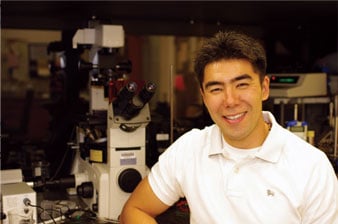 At least there could be soon, thanks to Peter Lillehoj ’06 and a team of researchers at a UCLA laboratory. The team is at work on a cell phone-based biosensor that would-in about 15 minutes-make the diagnostic call on a disease that can kill if not treated within 24 hours of the onset of symptoms.
At least there could be soon, thanks to Peter Lillehoj ’06 and a team of researchers at a UCLA laboratory. The team is at work on a cell phone-based biosensor that would-in about 15 minutes-make the diagnostic call on a disease that can kill if not treated within 24 hours of the onset of symptoms.
The promising research recently earned a $100,000 grant from the Bill and Melinda Gates Foundation, but Lillehoj says there hasn’t been much time to celebrate. “We just started with the project a few months ago, so we haven’t had enough time to develop the research and come up with a working prototype,” he says.
All his team has to do, after all, is fit the equivalent of a medical laboratory onto a platform the size of your basic SIM chip, the tiny memory bank of a cell phone. Currently, blood drawn from a patient is sent off to a laboratory for diagnosis, a time-consuming process in developing nations where that lab might be a town or more away. “Whatever the sample, probably blood in this case, it is dispensed on the sensor, which plugs into the phone,” explains Lillehoj, now a postdoctoral researcher at UCLA. “The phone then uses an app to perform the detection and make the diagnosis.”
Why a cell phone? In the next 10 to 15 years, about 80 percent of people in the world will own one, Lillehoj says, even in developing countries where malaria has had the most devastating impact. And the tiny chip would be less cumbersome and quicker than other malaria fighters in the works, including another from researchers at UCLA, a microscope attachment that allows a cell phone to transmit images of blood to a hospital for analysis. For now, though, a technician would be required to manipulate Lillehoj’s device as well. “We’re still working on making the testing process more user-friendly, which would allow for untrained and illiterate users to perform the procedure,” he says.
The vote of confidence from the Gates Foundation, says Lillehoj, is more proof that the research track he first embarked upon in a Hopkins mechanical engineering lab course on microfluidics and biodetection is the correct one. “Improving health care in developing countries is something that I’ve always been interested in,” he says. The Hopkins training gave him a way of channeling that interest. “It made me see the applications for this type of research-there are so many.”
“I’m really hoping that once we produce a working prototype we can apply for more funding and commercialize the device because this has great potential to improve the diagnosis of not just malaria but many other deadly diseases, including HIV, tuberculosis, and even cancer,” he says, noting that it can take five to 10 years and millions of dollars to move from invention to commercialization.
He explains that the sensor will be modifiable, set to search for different disease biomarkers, and able to offer quantitative information key to diagnosing the severity of an infection.
Lillehoj predicts that the first prototype biosensor might be available for testing by year’s end. Success with laboratory antigens and then more complex blood serums would lead to testing on actual human blood and, finally, trials in malaria hot spots, which would be fine with Lillehoj.
“I love to travel,” he says of previous journeys to nations like Mozambique, Mexico, Jamaica, and India, where malaria is a major public health threat, “so field testing is something that I would love to do.”




